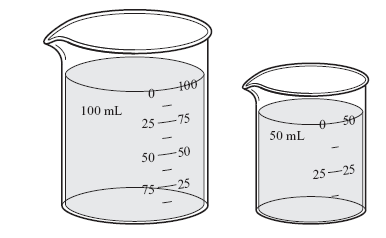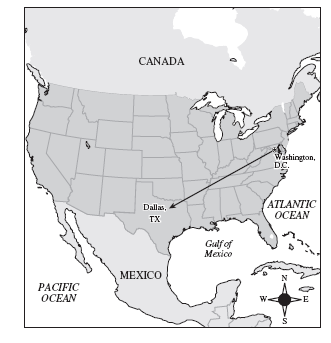Mrs. Collette's Science Quiz

10 MOTION QUESTIONS
- 1.
1) Tobias rode his bike on a road for a 2 hr period. On average, he passed a 1 km marker every 3 min during this period. Which of the following was his average speed for this 2 hr period?
- A.
10 kph
- B.
15 kph
- C.
20 kph
- D.
25 kph
Correct Answer
C. 20 kphExplanation
Tobias passed a 1 km marker every 3 minutes. To find his average speed, we need to convert this information into kilometers per hour. There are 60 minutes in an hour, so in 2 hours (120 minutes), Tobias would pass a 1 km marker 40 times (120 minutes divided by 3 minutes). This means he traveled a total of 40 km in 2 hours. Therefore, his average speed is 40 km divided by 2 hours, which equals 20 kph.Rate this question:
-
- 2.
2) Which of the following keeps the planets in our solar system in orbit around the Sun?
- A.
Atmospheric pressure
- B.
Gravitational force
- C.
Electromagnetic energy
- D.
Thermal energy
Correct Answer
B. Gravitational forceExplanation
Gravitational force is the correct answer because it is the force of attraction between two objects with mass. In the case of the planets in our solar system, the gravitational force between them and the Sun is what keeps them in orbit. The Sun's mass creates a gravitational pull that keeps the planets moving in a curved path around it, preventing them from drifting off into space. This force is responsible for maintaining the stability and structure of our solar system.Rate this question:
-
- 3.
3) An escalator at a shopping mall is 10 m long and moves at a constant speed of 0.5 m/s. If José steps onto the escalator at the bottom while it is moving, how long will it take him to travel the 10 m?
- A.
5 seconds
- B.
10 seconds
- C.
15 seconds
- D.
20 seconds
Correct Answer
D. 20 secondsExplanation
Since the escalator is moving at a constant speed of 0.5 m/s, it will take 20 seconds for José to travel the 10 m distance. This can be calculated by dividing the distance (10 m) by the speed (0.5 m/s), which gives us 20 seconds.Rate this question:
-
- 4.
4) The Moon orbits Earth at a speed of approximately one kilometer per second. The Moon is kept in orbit by which of the following?
- A.
Lunar phases
- B.
Magnetism
- C.
Ocean tides
- D.
Gravity
Correct Answer
D. GravityExplanation
The Moon is kept in orbit by gravity. Gravity is the force of attraction between two objects with mass. In this case, the Earth's gravity pulls the Moon towards it, keeping it in orbit. The Moon's speed of approximately one kilometer per second is a result of the balance between the gravitational force pulling it towards Earth and the Moon's own inertia trying to keep it moving in a straight line. This gravitational force is what keeps the Moon in a stable orbit around Earth.Rate this question:
-
- 5.
Physic5) The graph below relates distance to time for a rolling ball.What is the average speed of the ball?
- A.
2 m/s
- B.
6 m/s
- C.
8 m/s
- D.
72 m/s
Correct Answer
A. 2 m/sExplanation
The average speed of the ball can be determined by finding the slope of the line on the graph. In this case, the slope is equal to the change in distance divided by the change in time. Since the graph shows a straight line with a constant slope, the average speed of the ball is equal to the slope of the line. Therefore, the average speed of the ball is 2 m/s.Rate this question:
-
- 6.
al6) The drawing below shows part of a graduated cylinder containing liquid. Based on the sensitivity of the graduated cylinder, what is the volume of the liquid?
- A.
70.5 mL
- B.
73.0 mL
- C.
76.7 mL
- D.
87.0 mL
Correct Answer
B. 73.0 mLExplanation
Based on the sensitivity of the graduated cylinder, the volume of the liquid is 73.0 mL. This can be determined by looking at the markings on the graduated cylinder and identifying the closest value to the level of the liquid in the drawing. In this case, the closest value is 73.0 mL.Rate this question:
-
- 7.
7) The two beakers below contain pure water. Which of the following properties is the same for both of these samples?
- A.
Mass
- B.
Weight
- C.
Volume
- D.
Boiling point
Correct Answer
D. Boiling pointExplanation
The boiling point is the same for both samples of pure water because it is a physical property that is determined by the substance itself, regardless of the amount or size of the sample.Rate this question:
-
- 8.
8) The diagram below shows the path of a jet from Washington, D.C. to Dallas, TX. The trip takes approximately 2 hours and covers approximately 1900 km. Which of the following best describes the speed and direction of the jet’s flight?
- A.
475 km/h southwest
- B.
950 km/h southwest
- C.
1900 km/h southwest
- D.
3800 km/h southwest
Correct Answer
B. 950 km/h southwestExplanation
The correct answer is 950 km/h southwest. This means that the jet is traveling at a speed of 950 km/h in the southwest direction. The speed is important because it tells us how fast the jet is moving. The direction is also important because it tells us which way the jet is heading. In this case, the jet is heading southwest, which means it is moving in a direction that is between south and west.Rate this question:
-
- 9.
9) In order for a glider to fly, its weight must be opposed by
- A.
Lift
- B.
Drag
- C.
Gravity
- D.
Friction
Correct Answer
A. LiftExplanation
In order for a glider to fly, its weight must be opposed by lift. Lift is the force that acts in an upward direction and is generated by the wings of the glider. It counteracts the force of gravity, allowing the glider to stay airborne. Drag is the force that opposes the motion of the glider through the air, gravity is the force that pulls the glider downwards, and friction is the force that opposes the motion of the glider on the surface it is moving on. None of these forces directly oppose the weight of the glider like lift does.Rate this question:
-
- 10.
10) The graph below relates distance to time for a jogger on a morning run. Juan is on a morning jog. His speed is represented in the graph. Between what time period did Juan stop for a water break?
- A.
Between 0 and 3 minutes
- B.
Between 4 and 6 minutes
- C.
Between 7 and 11 minutes
- D.
Between 12 and 15 minutes
Correct Answer
C. Between 7 and 11 minutesExplanation
Based on the graph, we can see that there is a flat line between 7 and 11 minutes, indicating that the jogger stopped during this time period. Therefore, Juan stopped for a water break between 7 and 11 minutes.Rate this question:
-
Quiz Review Timeline +
Our quizzes are rigorously reviewed, monitored and continuously updated by our expert board to maintain accuracy, relevance, and timeliness.
-
Current Version
-
Feb 03, 2023Quiz Edited by
ProProfs Editorial Team -
Feb 04, 2009Quiz Created by
Lcollette
 Back to top
Back to top







